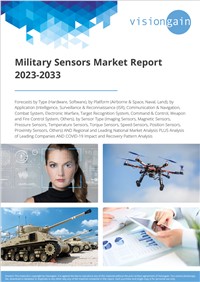The Military Sensors Market Report 2023-2033: This report will prove invaluable to leading firms striving for new revenue pockets if they wish to better understand the industry and its underlying dynamics. It will be useful for companies that would like to expand into different industries or to expand their existing operations in a new region.
Growing Military Spending on Sensor Technology
The increasing importance of sensor technology in modern warfare has led to a growing trend of military spending on this area. Sensors are essential for collecting information about the environment, such as temperature, humidity, light, and sound, and detecting the presence of objects or individuals in the vicinity.
The development and deployment of sensors for military purposes have become more important in recent years due to the emergence of asymmetric warfare, where small, mobile, and agile units operate in complex environments. In such scenarios, sensors can provide real-time situational awareness, enabling commanders to make informed decisions.
In addition, the rapid advancement of sensor technology, such as the miniaturization of sensors and the integration of artificial intelligence (AI), has led to new capabilities, such as autonomous vehicles, drones, and robots. These technologies can provide new ways of gathering intelligence, surveillance, and reconnaissance (ISR), and can even carry out missions independently, reducing the risk to human personnel.
Stringent Regulations Related to Military Sensor Systems
Stringent regulations related to military sensor systems are essential for several reasons. First and foremost, military sensor systems are used to collect critical intelligence and provide situational awareness in combat scenarios. Therefore, any malfunction or error in the system could result in serious consequences, including loss of life or damage to military assets. Stringent regulations can help ensure that these systems meet rigorous standards of quality, reliability, and performance.
Secondly, military sensor systems often involve advanced technologies and sensitive data, including classified information. Unauthorized access or misuse of this information could compromise national security and put military personnel at risk. Regulations can help ensure that these systems are designed with appropriate security measures and that access to them is restricted only to authorized personnel.
What Questions Should You Ask before Buying a Market Research Report?
- How is the military sensors market evolving?
- What is driving and restraining the military sensors market?
- How will each military sensors submarket segment grow over the forecast period and how much revenue will these submarkets account for in 2033?
- How will the market shares for each military sensors submarket develops from 2023 to 2033?
- What will be the main driver for the overall market from 2023 to 2033?
- Will leading military sensors markets broadly follow the macroeconomic dynamics, or will individual national markets outperform others?
- How will the market shares of the national markets change by 2033 and which geographical region will lead the market in 2033?
- Who are the leading players and what are their prospects over the forecast period?
- What are the military sensors projects for these leading companies?
- How will the industry evolve during the period between 2023 and 2033? What are the implications of military sensors projects taking place now and over the next 10 years?
- Is there a greater need for product commercialisation to further scale the military sensors market?
- Where is the military sensors market heading and how can you ensure you are at the forefront of the market?
You need to discover how this will impact the military sensors market today, and over the next 10 years:
- Our 328-page report provides 130 tables and 203 charts/graphs exclusively to you.
- The report highlights key lucrative areas in the industry so you can target them – NOW.
- It contains in-depth analysis of global, regional and national sales and growth.
- It highlights for you the key successful trends, changes and revenue projections made by your competitors.
This report tells you TODAY how the military sensors market will develop in the next 10 years, and in line with the variations in COVID-19 economic recession and bounce. This market is more critical now than at any point over the last 10 years.
Forecasts to 2033 and other analyses reveal commercial prospects
- In addition to revenue forecasting to 2033, our new study provides you with recent results, growth rates, and market shares.
- You will find original analyses, with business outlooks and developments.
- Discover qualitative analyses (including market dynamics, drivers, opportunities, restraints, and challenges), porters five forces analysis, PEST analysis, and recent developments.
Segments Covered in the Report
Type Outlook
- Hardware
- Software
Platform Outlook
- Airborne & Space
- Naval
- Land
Application Outlook
- Intelligence, Surveillance & Reconnaissance (ISR)
- Communication & Navigation
- Combat System
- Electronic Warfare
- Target Recognition System
- Command & Control
- Weapon and Fire Control System
- Others
Sensor Type Outlook
- Imaging Sensors
- Magnetic Sensors
- Pressure Sensors
- Temperature Sensors
- Torque Sensors
- Speed-Sensors
- Position Sensors
- Proximity Sensors
- Others




